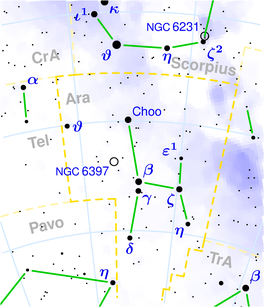Beta Arae
Beta Arae (afgekort as β Ara) is met ’n skynbare magnitude van 2,8[3] die helderste ster in die suidelike sterrebeeld Altaar (Ara). Dit is sowat 650 ligjare van die Son af.[2]
| Beta Arae
| ||||

| ||||
| Die ligging van Beta Arae (in die rooi sirkel). | ||||
| Sterrebeeld | Altaar | |||
| Bayer-naam | β Arae | |||
| Spektraaltipe | K3 Ib-II[1] | |||
| Soort | Helder reus/superreus | |||
| Waarnemingsdata (Epog J2000) | ||||
| Regte klimming | 17h 25m 17.98835s[2] | |||
| Deklinasie | -55° 31′ 47.5868″[2] | |||
| Skynmagnitude (m) | 2,84[3] | |||
| Absolute magnitude (M) | -3,494[4] | |||
| B-V-kleurindeks | +1,46[5] | |||
| U-B-kleurindeks | +1,56[5] | |||
| Besonderhede | ||||
| Massa (M☉) | 8,21[6] | |||
| Ligsterkte (L☉) | 5 636[6] | |||
| Ouderdom (jaar) | 50,1 miljoen[7] | |||
| Ander name | ||||
| CPD −55° 8100, FK5 645, HD 157244, HIP 85258, HR 6461, SAO 244725.[8] | ||||
| ||||
Die ster het ’n sterreklassifikasie van K3 Ib-IIa[1] met die ligsterkteklas "Ib-IIa", wat daarop dui dit is halfpad tussen ’n helder reus (IIa) en ’n superreus (Ib). Dit is twee van die evolusionêre stadiums waardeur ’n ster met ’n groot massa gaan nadat dit al die waterstof in sy kern opgebruik het. Beta Arae het ’n oppervlaktemperatuur van 4 200 K, wat meebring dat dit die oranje skynsel van ’n K-tipe ster het.[9]
Dit lyk of hierdie vergrote ster stadig roteer teen ’n snelheid van sowat 5 km/s.[1] Sy hoeveelheid elemente swaarder as waterstof en helium, wat sterrekundiges metale noem, is drie keer so groot as in die Son.[1][10]
Verwysings
wysig- ↑ 1,0 1,1 1,2 1,3 De Medeiros, J. R. et al. (November 2002), "A catalog of rotational and radial velocities for evolved stars. II. Ib supergiant stars", Astronomy and Astrophysics 395: 97–98, doi:10.1051/0004-6361:20021214, Bibcode: 2002A&A...395...97D
- ↑ 2,0 2,1 2,2 van Leeuwen, F. (November 2007), "Validation of the new Hipparcos reduction", Astronomy and Astrophysics 474 (2): 653–664, doi:10.1051/0004-6361:20078357, Bibcode: 2007A&A...474..653V
- ↑ 3,0 3,1 Wielen, R. et al. (1999), "Sixth Catalogue of Fundamental Stars (FK6). Part I. Basic fundamental stars with direct solutions", Veröff. Astron. Rechen-Inst. Heidelb (Astronomisches Rechen-Institut Heidelberg) 35 (35), Bibcode: 1999VeARI..35....1W
- ↑ Cassatella, A.; Altamore, A.; Badiali, M.; Cardini, D. (2001). "On the Wilson-Bappu relationship in the Mg II k line". Astronomy and Astrophysics. 374 (3): 1085. Bibcode:2001A&A...374.1085C. doi:10.1051/0004-6361:20010816.
- ↑ 5,0 5,1 Johnson, H. L. et al. (1966), "UBVRIJKL photometry of the bright stars", Communications of the Lunar and Planetary Laboratory 4 (99): 99, Bibcode: 1966CoLPL...4...99J
- ↑ 6,0 6,1 Heiter, U.; Jofré, P.; Gustafsson, B.; Korn, A. J.; Soubiran, C.; Thévenin, F. (2015). "Gaia FGK benchmark stars: Effective temperatures and surface gravities". Astronomy & Astrophysics. 582: A49. arXiv:1506.06095. Bibcode:2015A&A...582A..49H. doi:10.1051/0004-6361/201526319.
- ↑ Tetzlaff, N.; Neuhäuser, R.; Hohle, M. M. (January 2011), "A catalogue of young runaway Hipparcos stars within 3 kpc from the Sun", Monthly Notices of the Royal Astronomical Society 410 (1): 190–200, doi:10.1111/j.1365-2966.2010.17434.x, Bibcode: 2011MNRAS.410..190T
- ↑ "bet Ara -- Star". SIMBAD (in Engels). Centre de Données astronomiques de Strasbourg. Geargiveer vanaf die oorspronklike op 5 April 2016. Besoek op 15 Januarie 2012.
- ↑ "The Colour of Stars", Australia Telescope, Outreach and Education (Commonwealth Scientific and Industrial Research Organisation), December 21, 2004, archived from the original on 2012-03-10, https://www.webcitation.org/6630AbtJZ?url=http://outreach.atnf.csiro.au/education/senior/astrophysics/photometry_colour.html, besoek op 2012-01-16
- ↑ The abundance is estimated by taking [Fe/H] to the power of ten, thus:
- 10[Fe/H] = 10+0.5 = 3.1
Eksterne skakels
wysig- Kaler, James B., "BETA ARA (Beta Arae)", Stars (Universiteit van Illinois), http://stars.astro.illinois.edu/sow/betaara.html, besoek op 2012-01-15
- HR 6461
- Foto van Beta Arae by Aladin
- Beta Arae op WikiSky: DSS2, SDSS, GALEX, IRAS, Hydrogen α, X-Ray, Astrophoto, Sky Map, Artikels en foto's
- Hierdie artikel is vertaal uit die Engelse Wikipedia